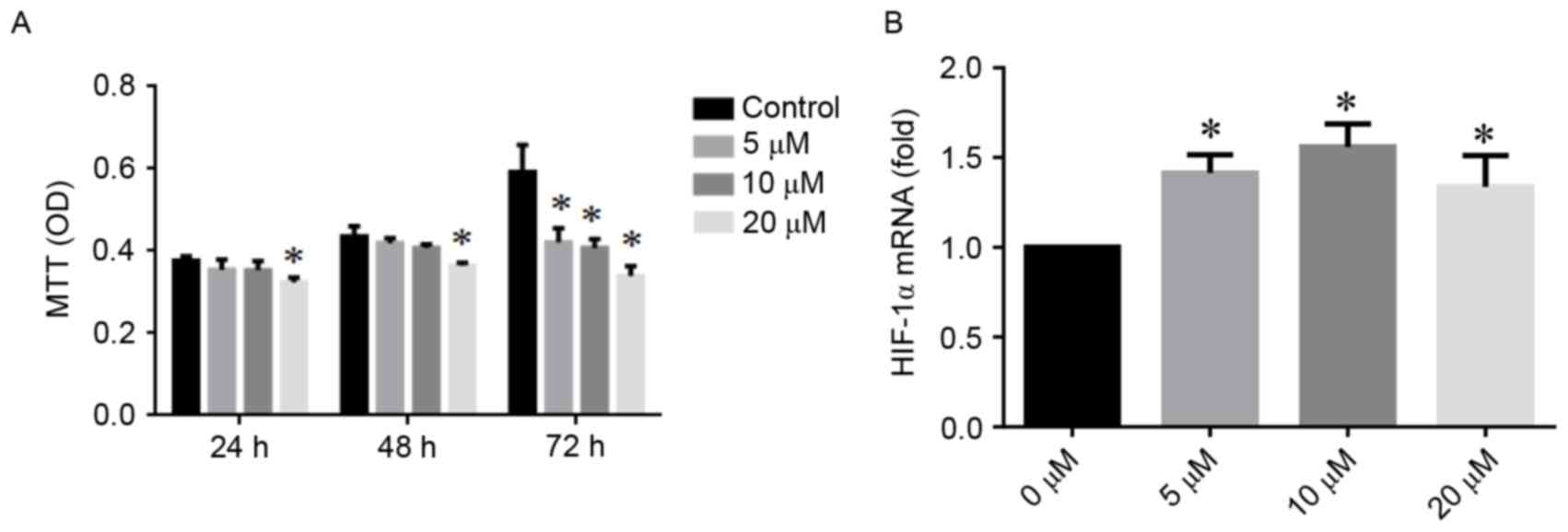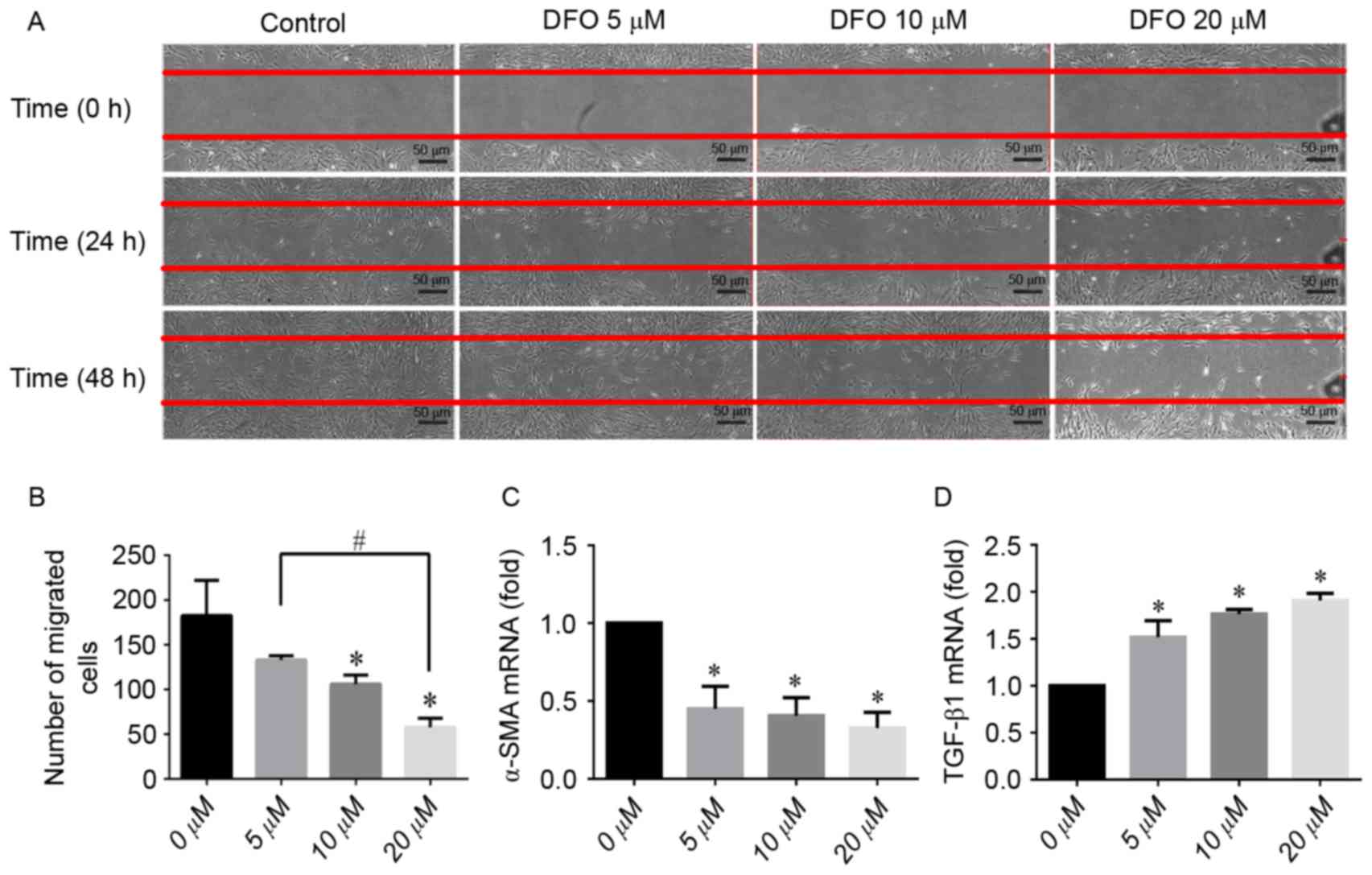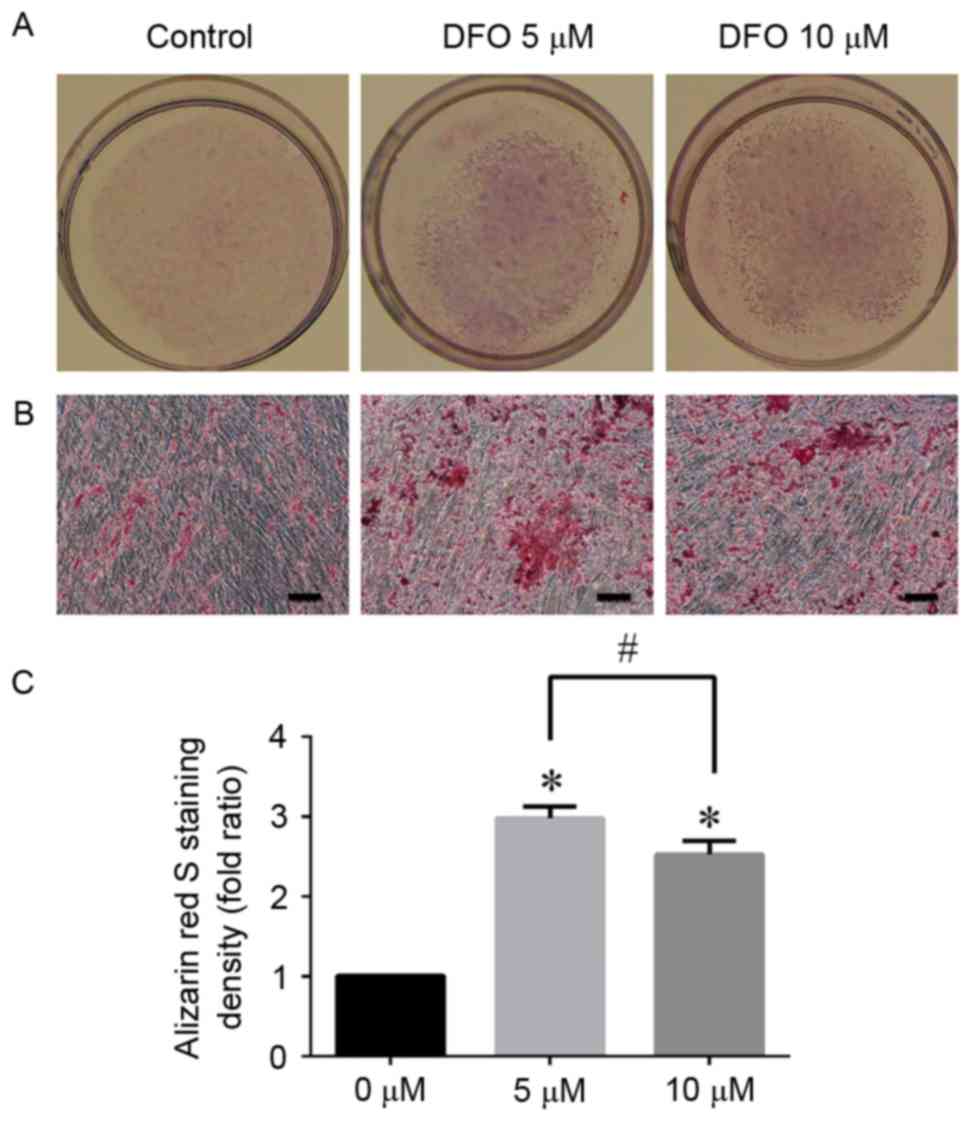|
1
|
Chai Y, Jiang X, Ito Y, Bringas P Jr, Han
J, Rowitch DH, Soriano P, McMahon AP and Sucov HM: Fate of the
mammalian cranial neural crest during tooth and mandibular
morphogenesis. Development. 127:1671–1679. 2000.PubMed/NCBI
|
|
2
|
Beertsen W, McCulloch Ca and Sodek J: The
periodontal ligament: A unique, multifunctional connective tissue.
Periodontol 2000. 13:20–40. 1997. View Article : Google Scholar : PubMed/NCBI
|
|
3
|
Alvarez R, Lee HL, Wang CY and Hong C:
Characterization of the osteogenic potential of mesenchymal stem
cells from human periodontal ligament based on cell surface
markers. Int J Oral Sci. 7:213–219. 2015. View Article : Google Scholar : PubMed/NCBI
|
|
4
|
Seo BM, Miura M, Gronthos S, Bartold PM,
Batouli S, Brahim J, Young M, Robey PG, Wang CY and Shi S:
Investigation of multipotent postnatal stem cells from human
periodontal ligament. Lancet. 364:149–155. 2004. View Article : Google Scholar : PubMed/NCBI
|
|
5
|
Semenza GL: Hypoxia-inducible factor 1:
Oxygen homeostasis and disease pathophysiology. Trends Mol Med.
7:345–350. 2001. View Article : Google Scholar : PubMed/NCBI
|
|
6
|
Harris AL: Hypoxia-a key regulatory factor
in tumour growth. Nat Rev Cancer. 2:38–47. 2002. View Article : Google Scholar : PubMed/NCBI
|
|
7
|
Eltzschig HK and Carmeliet P: Hypoxia and
inflammation. N Engl J Med. 364:656–665. 2011. View Article : Google Scholar : PubMed/NCBI
|
|
8
|
Simon MC and Keith B: The role of oxygen
availability in embryonic development and stem cell function. Nat
Rev Mol Cell Biol. 9:285–296. 2008. View
Article : Google Scholar : PubMed/NCBI
|
|
9
|
Ren H, Cao Y, Zhao Q, Li J, Zhou C, Liao
L, Jia M, Zhao Q, Cai H, Han ZC, et al: Proliferation and
differentiation of bone marrow stromal cells under hypoxic
conditions. Biochem Biophys Res Commun. 347:12–21. 2006. View Article : Google Scholar : PubMed/NCBI
|
|
10
|
Wan C, Gilbert SR, Wang Y, Cao X, Shen X,
Ramaswamy G, Jacobsen KA, Alaql ZS, Eberhardt AW, Gerstenfeld LC,
et al: Activation of the hypoxia-inducible factor-1 pathway
accelerates bone regeneration. Proc Natl Acad Sci USA. 105:pp.
686–691. 2008; View Article : Google Scholar : PubMed/NCBI
|
|
11
|
Ivan M, Kondo K, Yang H, Kim W, Valiando
J, Ohh M, Salic A, Asara JM, Lane WS and Kaelin WG Jr: HIFalpha
targeted for VHL-mediated destruction by proline hydroxylation:
Implications for O2 sensing. Science. 292:464–468. 2001. View Article : Google Scholar : PubMed/NCBI
|
|
12
|
Semenza GL: HIF-1: Mediator of
physiological and pathophysiological responses to hypoxia. J Appl
Physiol (1985). 88:1474–1480. 2000.PubMed/NCBI
|
|
13
|
Bruick RK and McKnight SL: A conserved
family of prolyl-4-hydroxylases that modify HIF. Science.
294:1337–1340. 2001. View Article : Google Scholar : PubMed/NCBI
|
|
14
|
Ceradini DJ, Kulkarni AR, Callaghan MJ,
Tepper OM, Bastidas N, Kleinman ME, Capla JM, Galiano RD, Levine JP
and Gurtner GC: Progenitor cell trafficking is regulated by hypoxic
gradients through HIF-1 induction of SDF-1. Nat Med. 10:858–864.
2004. View
Article : Google Scholar : PubMed/NCBI
|
|
15
|
Zhao T, Zhang CP, Liu ZH, Wu LY, Huang X,
Wu HT, Xiong L, Wang X, Wang XM, Zhu LL and Fan M: Hypoxia-driven
proliferation of embryonic neural stem/progenitor cells-role of
hypoxia-inducible transcription factor-1alpha. FEBS J.
275:1824–1834. 2008. View Article : Google Scholar : PubMed/NCBI
|
|
16
|
Wang Y, Wan C, Deng L, Liu X, Cao X,
Gilbert SR, Bouxsein ML, Faugere MC, Guldberg RE, Gerstenfeld LC,
et al: The hypoxia-inducible factor alpha pathway couples
angiogenesis to osteogenesis during skeletal development. J Clin
Invest. 117:1616–1626. 2007. View
Article : Google Scholar : PubMed/NCBI
|
|
17
|
Hirsilä M, Koivunen P, Xu L, Seeley T,
Kivirikko KI and Myllyharju J: Effect of desferrioxamine and metals
on the hydroxylases in the oxygen sensing pathway. FASEB J.
19:1308–1310. 2005.PubMed/NCBI
|
|
18
|
Qu ZH, Zhang XL, Tang TT and Dai KR:
Promotion of osteogenesis through beta-catenin signaling by
desferrioxamine. Biochem Biophys Res Commun. 370:332–337. 2008.
View Article : Google Scholar : PubMed/NCBI
|
|
19
|
Livak KJ and Schmittgen TD: Analysis of
relative gene expression data using real-time quantitative PCR and
the 2(-Delta Delta C(T)) method. Methods. 25:402–408. 2001.
View Article : Google Scholar : PubMed/NCBI
|
|
20
|
Pihlstrom BL, Michalowicz BS and Johnson
NW: Periodontal diseases. Lancet. 366:1809–1820. 2005. View Article : Google Scholar : PubMed/NCBI
|
|
21
|
Lennon DP, Edmison JM and Caplan AI:
Cultivation of rat marrow-derived mesenchymal stem cells in reduced
oxygen tension: Effects on in vitro and in vivo
osteochondrogenesis. J Cell Physiol. 187:345–355. 2001. View Article : Google Scholar : PubMed/NCBI
|
|
22
|
Nurtjahja-Tjendraputra E, Fu D, Phang JM
and Richardson DR: Iron chelation regulates cyclin D1 expression
via the proteasome: A link to iron deficiency-mediated growth
suppression. Blood. 109:4045–4054. 2007. View Article : Google Scholar : PubMed/NCBI
|
|
23
|
Chen D, Li Y, Zhou Z, Wu C, Xing Y, Zou X,
Tian W and Zhang C: HIF-1α inhibits Wnt signaling pathway by
activating Sost expression in osteoblasts. PLoS One. 8:e659402013.
View Article : Google Scholar : PubMed/NCBI
|
|
24
|
Zeng HL, Zhong Q, Qin YL, Bu QQ, Han XA,
Jia HT and Liu HW: Hypoxia-mimetic agents inhibit proliferation and
alter the morphology of human umbilical cord-derived mesenchymal
stem cells. BMC Cell Biol. 12:322011. View Article : Google Scholar : PubMed/NCBI
|
|
25
|
Callens C, Coulon S, Naudin J,
Radford-Weiss I, Boissel N, Raffoux E, Wang PH, Agarwal S, Tamouza
H, Paubelle E, et al: Targeting iron homeostasis induces cellular
differentiation and synergizes with differentiating agents in acute
myeloid leukemia. J Exp Med. 207:731–750. 2010. View Article : Google Scholar : PubMed/NCBI
|
|
26
|
Stein GS, Lian JB and Owen TA:
Relationship of cell growth to the regulation of tissue-specific
gene expression during osteoblast differentiation. FASEB J.
4:3111–3123. 1990.PubMed/NCBI
|
|
27
|
Sun J, Zhang D, Zheng Y, Zhao Q, Zheng M,
Kovacevic Z and Richardson DR: Targeting the metastasis suppressor,
NDRG1, using novel iron chelators: Regulation of stress
fiber-mediated tumor cell migration via modulation of the
ROCK1/pMLC2 signaling pathway. Mol Pharmacol. 83:454–469. 2013.
View Article : Google Scholar : PubMed/NCBI
|
|
28
|
Chen Z, Zhang D, Yue F, Zheng M, Kovacevic
Z and Richardson DR: The iron chelators Dp44mT and DFO inhibit
TGF-β-induced epithelial-mesenchymal transition via up-regulation
of N-Myc downstream-regulated gene 1 (NDRG1). J Biol Chem.
287:17016–17028. 2012. View Article : Google Scholar : PubMed/NCBI
|
|
29
|
Hinz B, Gabbiani G and Chaponnier C: The
NH2-terminal peptide of alpha-smooth muscle actin inhibits force
generation by the myofibroblast in vitro and in vivo. J Cell Biol.
157:657–663. 2002. View Article : Google Scholar : PubMed/NCBI
|
|
30
|
Modarressi A, Pietramaggiori G, Godbout C,
Vigato E, Pittet B and Hinz B: Hypoxia impairs skin myofibroblast
differentiation and function. J Invest Dermatol. 130:2818–2827.
2010. View Article : Google Scholar : PubMed/NCBI
|
|
31
|
Faulknor RA, Olekson MA, Nativ NI,
Ghodbane M, Gray AJ and Berthiaume F: Mesenchymal stromal cells
reverse hypoxia-mediated suppression of α-smooth muscle actin
expression in human dermal fibroblasts. Biochem Biophys Res Commun.
458:8–13. 2015. View Article : Google Scholar : PubMed/NCBI
|
|
32
|
Jin H, Terai S and Sakaida I: The iron
chelator deferoxamine causes activated hepatic stellate cells to
become quiescent and to undergo apoptosis. J Gastroenterol.
42:475–484. 2007. View Article : Google Scholar : PubMed/NCBI
|
|
33
|
Fujii S, Maeda H, Tomokiyo A, Monnouchi S,
Hori K, Wada N and Akamine A: Effects of TGF-β1 on the
proliferation and differentiation of human periodontal ligament
cells and a human periodontal ligament stem/progenitor cell line.
Cell Tissue Res. 342:233–242. 2010. View Article : Google Scholar : PubMed/NCBI
|
|
34
|
Zimmerman KA, Graham LV, Pallero MA and
Murphy-Ullrich JE: Calreticulin regulates transforming growth
factor-β-stimulated extracellular matrix production. J Biol Chem.
288:14584–14598. 2013. View Article : Google Scholar : PubMed/NCBI
|
|
35
|
Alizadeh N, Pepper MS, Modarressi A, Alfo
K, Schlaudraff K, Montandon D, Gabbiani G, Bochaton-Piallat ML and
Pittet B: Persistent ischemia impairs myofibroblast development in
wound granulation tissue: A new model of delayed wound healing.
Wound Repair Regen. 15:809–816. 2007. View Article : Google Scholar : PubMed/NCBI
|
|
36
|
McMahon S, Charbonneau M, Grandmont S,
Richard DE and Dubois CM: Transforming growth factor beta1 induces
hypoxia-inducible factor-1 stabilization through selective
inhibition of PHD2 expression. J Biol Chem. 281:24171–24181. 2006.
View Article : Google Scholar : PubMed/NCBI
|
|
37
|
Nagatomo K, Komaki M, Sekiya I, Sakaguchi
Y, Noguchi K, Oda S, Muneta T and Ishikawa I: Stem cell properties
of human periodontal ligament cells. J Periodontal Res. 41:303–310.
2006. View Article : Google Scholar : PubMed/NCBI
|
|
38
|
Murakami Y, Kojima T, Nagasawa T,
Kobayashi H and Ishikawa I: Novel isolation of alkaline
phosphatase-positive subpopulation from periodontal ligament
fibroblasts. J Periodontol. 74:780–786. 2003. View Article : Google Scholar : PubMed/NCBI
|
|
39
|
Wu C, Zhou Y, Lin C, Chang J and Xiao Y:
Strontium-containing mesoporous bioactive glass scaffolds with
improved osteogenic/cementogenic differentiation of periodontal
ligament cells for periodontal tissue engineering. Acta Biomater.
8:3805–3815. 2012. View Article : Google Scholar : PubMed/NCBI
|
|
40
|
Vimalraj S, Arumugam B, Miranda PJ and
Selvamurugan N: Runx2: Structure, function, and phosphorylation in
osteoblast differentiation. Int J Biol Macromol. 78:202–208. 2015.
View Article : Google Scholar : PubMed/NCBI
|
|
41
|
Jensen ED, Gopalakrishnan R and Westendorf
JJ: Regulation of gene expression in osteoblasts. Biofactors.
36:25–32. 2010.PubMed/NCBI
|
|
42
|
Elanagai R, Veeravarmal V and Nirmal RM:
Osteopontin expression in reactive lesions of gingiva. J Appl Oral
Sci. 23:26–32. 2015. View Article : Google Scholar : PubMed/NCBI
|
|
43
|
Mathews S, Bhonde R, Gupta PK and Totey S:
A novel tripolymer coating demonstrating the synergistic effect of
chitosan, collagen type 1 and hyaluronic acid on osteogenic
differentiation of human bone marrow derived mesenchymal stem
cells. Biochem Biophys Res Commun. 414:270–276. 2011. View Article : Google Scholar : PubMed/NCBI
|
|
44
|
Zhao GY, Zhao LP, He YF, Li GF, Gao C, Li
K and Xu YJ: A comparison of the biological activities of human
osteoblast hFOB1.19 between iron excess and iron deficiency. Biol
Trace Elem Res. 150:487–495. 2012. View Article : Google Scholar : PubMed/NCBI
|














